Swarming bee traps
- Bernard Preston homepage
- Beekeeping
- Swarming Bee Traps
Swarming bee traps explains how to entice a feral colony that is swarming by; rather they choose your empty hive for a home than in your roof or under the bath.
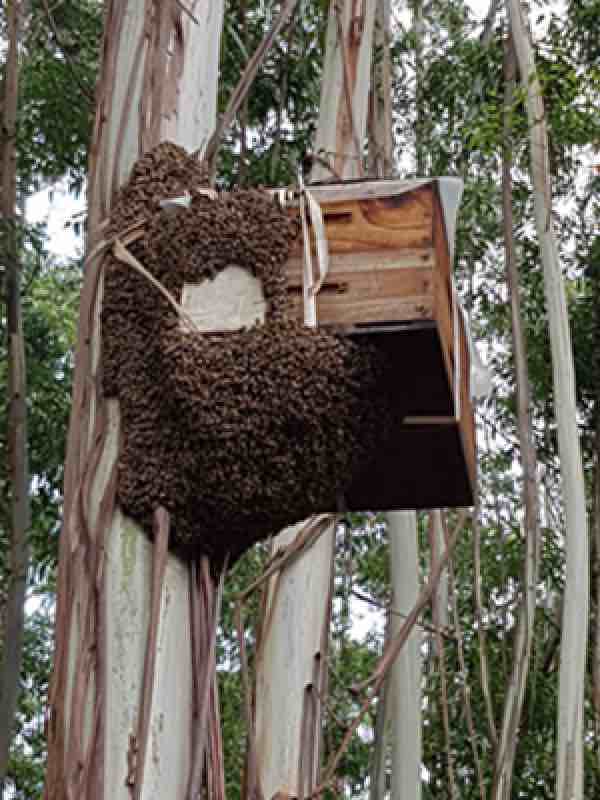
This page was last updated by Bernard Preston on 5th January, 2023.
When a colony has outgrown its home, be it in a tree stump, roof, or a proper commercial beehive, the bees start to build queen cells in preparation for swarming. About a week before the queens are due to hatch, scouts start looking for a suitable new place to make a nest.
It's vital to make the bee traps hospitable as possible. What do I mean by that?
- The bee trap must be about 2-4m above ground for best results; on a water tank, hanging in a tree, or on a shed roof. If you are placing several decoy hives out, vary the height.
- The trap must have been lived in, and have a "bee smell." Several months before the swarming season, purchase half a dozen new hives, and once they've aired for a few weeks, transfer an existing colony to one of the new boxes.
- The old hive makes the perfect bee trap.
If you have some old, black combs, break them up in a bucket of hot water and then paint the slush onto your new boxes, inside and out. It looks terrible but makes the perfect trap hive.
Inside the hive, three types of combs are necessary:
- About four frames with a narrow strip of wax foundation, perhaps one to two inches wide. This creates in the middle of the box a space for the new swarm to cluster. Swarming bees don't like full combs throughout the hive.
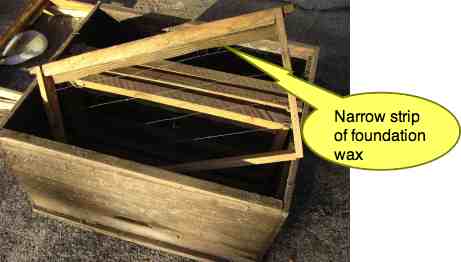
Another four frames, placed towards the outside with full foundation.
Full foundation has two advantages; the bees won't build drone cells, and there is immediately room for the queen to lay eggs for the developing colony.
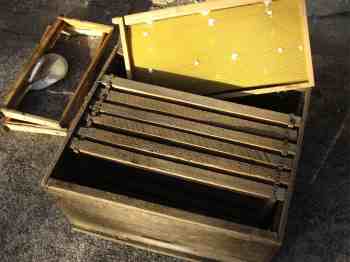
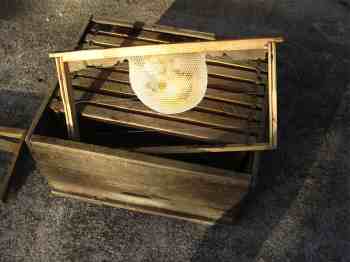
Now the next best option is to place this box on top of a strong colony for a week or two. They will start to draw out the foundation, but don't leave it too long; you do not want any honey or young brood in your trap. Take a peep every couple days to see how busy they have been.
Swarming bee traps
Swarming bee traps shows how to provide a hospitable environment in the new hive for attracting a colony that's migrating past. Make sure they choose your box, rather than go under the roof.
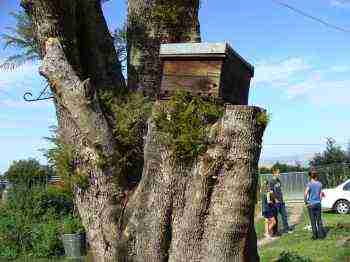
Raw honey
Choice grade honey is increasingly difficult to get; it's heated, over processed and adulterated. In addition, because of our desire to have it "pure" it is passed through many layers of filtering, removing all the pollen granules. The solution is your own swarming bee traps.
Half the value of honey is the pollen it contains; that is what helps with all our allergies; hay-fever, asthma and sinusitis.
If you desire to have raw honey, either start beekeeping as I did, or find a small apiarist in your neck of the woods. Find out when he or she is harvesting the crop, take a long several buckets to provide enough for a whole year. Ask if you can tap it straight from the tank before it's processed in any way.
Bottle it in glass jars as soon as you get home as most honeys will crystallise, and you don't want the whole bucket on the dining room table.
Beekeeping has been the chief fascination of my life; I've kept them for over fifty years in a corner of the garden, with the exception of a four year stint in Chicago whilst studying chiropractic. If you have indigenous honeybees, as we do, then traps will become part of your life.
More about that pollen
Research is now revealing that the pollen granules are surrounded by a very tough coating called the exine layer. To get the full benefits one has to ferment the honey.
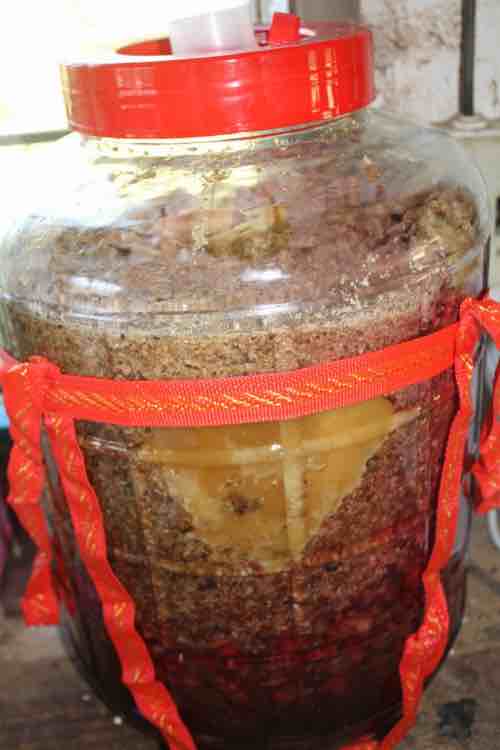 Ferment the honey and pollen.
Ferment the honey and pollen.Permaculture
Permaculture is all about working with nature, rather than against it; and ensuring that our great-grandchildren will be able to enjoy a habitable world as we have been privileged to. Swarming bee traps are but one tiny aspect of the whole.
Increasingly our world is seriously under threat from pollution. Soon scientists tell us there will be more plastic in the oceans than fish; and honey from farming areas contains toxic residues of plant poisons.
Newsletter
Our newsletter is entitled "create a cyan zone" at your home, preserving both yourself and Mother Earth for future generations; and the family too, of course. We promise not to spam you with daily emails promoting various products. You may get an occasional nudge to buy one of my books.
Here are the back issues.
- Lifestyle and ideal body weight
- What are ultra-processed foods?
- Investing in long-term health
- Diseases from plastic exposure
- Intensive lifestyle management for obesity has limited value
- A world largely devoid of Parkinson's Disease
- The impact of friendly bacteria in the tum on the prevention of cancer
- There's a hole in the bucket
- Everyone is talking about weight loss drugs
- Pull the sweet tooth
- If you suffer from heartburn plant a susu
- Refined maize meal and stunting
- Should agriculture and industry get priority for water and electricity?
- Nature is calling
- Mill your own flour
- Bake your own sourdough bread
- Microplastics from our water
- Alternative types of water storage
- Wear your clothes out
- Comfort foods
- Create a bee-friendly environment
- Go to bed slightly hungry
- Keep bees
- Blue zone folk are religious
- Reduce plastic waste
- Family is important
- What can go in compost?
- Grow broad beans for longevity
- Harvest and store sunshine
- Blue zone exercise
- Harvest and store your rainwater
- Create a cyan zone at your home
One in three mouthfuls that we eat coming directly from plants that have been pollinated by bees. They too are seriously under threat from pollution and insecticides.
If you are serious about the environment, then one of the best moves you could make would be to keep a beehive or two in your garden; and that means swarming bee traps.
Of course permaculture goes much further than swarming bee traps; it's all about maintaining a sustainable ecosystem; it's a vast subject.
For me it's all about growing organic vegetables sans toxic poisons, saving rainwater and building a solar farm that has made us close to going off the grid.
You will choose other facets of permaculture if you are concerned about our world; those things that fascinate you. But do something because we are destroying the beautiful planet the good Lord provided for us. It's no longer a garden of Eden. Many parts are polluted deathtraps.
Recycling all your plastic, glass, cans and paper would be a good start.
Bernard Preston
Bernard Preston is a semi-retired chiropractor with a passion for better health; that means less medication, better food and more exercise; and making swarming bee traps for natural honey as a sweetener. It has a low glycemic index unlike sugar.
It's no coincidence that neither Helen nor I take any medication at all, except for the very occasional acute crisis. We have regular chiropractic adjustments, grow our own vegetables and relish gardening for exercise; building compost heaps beats pumping iron. You have something to show for all your hard work.
And once a year, I'm putting up swarming bee traps to add a colony or two to our apiary, or helping others get started.
We never have difficulty with Christmas presents; a few bottles of Bernard Preston's honey always brings a smile of appreciation. There are no white elephants from our home.
MONTHLY NEWSLETTER
Barrie Lewis and Bernard Preston send out a joint monthly newsletter full of bits and pieces about better health. Number #46 is about how to prevent chronic lower back pain, important for beekeepers. Chiropractic Help backissues ...
Use the Site Search function in the navigation bar on your left to find the links to those topics like backissues highlighted in bold.
Did you find this page useful? Then perhaps forward this to a fellow bookworm.
- Bernard Preston homepage
- Beekeeping
- Swarming Bee Traps
Address:
56 Groenekloof Rd,
Hilton, KZN
South Africa
Website:
https://www.bernard-preston.com